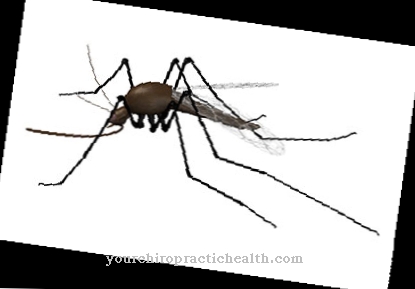As Urolithiasis is called a urinary stone disease. This leads to the formation of uroliths in the urinary tract.
What is urolithiasis?
Urolithiasis is the medical name for the presence of uroliths within the urinary tract such as the urinary bladder and ureter or the renal pelvis. Urinary stones are pathological structures made up of different crystals. As a rule, the urinary stones are formed from calcium oxalate and come about in the kidneys.
If they are deposited there, there is talk of kidney stones. But there is also the possibility of the stones being deposited in the urinary tract and the urinary bladder. Doctors then speak of urinary stones or bladder stones. In contrast, the stones are rarely deposited in the urethra.
Depending on the type of salt that makes up a urinary stone, in urolithiasis between calcium oxalate stones, which make up around 75 percent of urinary stones, struvite stones (about ten percent), calcium phosphate stones (about five percent), urate stones from uric acid (about five percent) and A distinction is made between rare xanthine stones and cystine stones.
The type of urinary stones plays an important role in determining the cause of the disease as well as for diagnosis and therapy. In Germany alone, around six percent of all people suffer from urolithiasis. Men get sick twice as often as women. Seniors and overweight people are particularly affected.
causes
The causes of urolithiasis are different. Usually several factors play a role at the same time. Urinary stones form when more substances are excreted in the urine that promote the development of urolithiasis. These are lithogenic substances such as oxalic acid, calcium and phosphates. In addition, fewer substances are excreted that counteract the formation of urinary stones.
These are mainly citrate and magnesium. Furthermore, the critical urine pH is between 5.5 and 7.0. Eventually, excessively concentrated urine will be excreted. The factors are considered typical of urolithiasis. They are often associated with osteoporosis (bone loss), overactive thyroid and vitamin D overdose.
Other possible risk factors for the development of urolithiasis include urinary tract infections, the accumulation of urine due to anatomical drainage disorders or neurogenic bladder emptying disorders, and a lack of exercise. A diet rich in protein can also play a role.
In Germany, for example, a diet with foods containing oxalic acid and the consumption of animal fats are classified as conducive to the formation of urinary stones. Foods that contain oxalic acid include coffee, cocoa, spinach, beetroot, and rhubarb. The stone-forming substances such as oxalate can only be dissolved in the urine up to a certain amount and transported out of the organism.
If this amount is exceeded through food, there is a risk of precipitation of the stone-forming substances. Insufficient fluid intake and diets are additional risks for urolithiasis.
Symptoms, ailments & signs
Urolithiasis does not initially cause any symptoms. These only arise when the urinary tract is obstructed by the urinary stones. Then different symptoms appear. A staccatome is considered characteristic of urolithiasis. The urine stream breaks off several times during urination. The bladder outlet is repeatedly closed by the movable urinary stone, which in turn interrupts continuous urination.
Furthermore, with urolithiasis, small amounts of urine, the feeling of foreign bodies, constant urge to urinate, blood in the urine, bladder spasms with colic-like pain and pain when urinating can occur. In men, the symptoms often radiate to the tip of the penis.
Diagnosis & course of disease
If the urolithiasis leads the patient to the doctor, he first asks about the pain, on which occasions it occurs and whether the patient has ever dealt with urinary stones. A physical examination will take place after the survey. Urine and blood are also checked.
Some imaging techniques are also considered helpful. Sonography (ultrasound examination) and an X-ray examination are used to determine the position and size of the urinary stones. The X-rays can also provide information on the chemical composition of the stones.
Another useful diagnostic method is the mirroring of the bladder with an endoscope. Smaller bladder stones can often even be removed. The course of urolithiasis is usually positive. Around 75 percent of all urinary stones pass by themselves with conservative treatment. However, around 50 percent of all patients suffer from the formation of new urinary stones.
Complications
Urolithiasis can cause urinary congestion, which among other things causes inflammation and an imbalance in the acid-base balance and electrolyte balance. If untreated, urine congestion can lead to kidney infection or even blood poisoning. This is accompanied by severe pain, which ties the person to bed and massively restricts the quality of life.
A sudden congestion of urine can cause a rupture of the fornix, in which the kidney calyx tears and urine leaks out. If a urinary stone presses on the calyx, it can lead to a kidney abscess. If the course is severe, there is a complete or partial failure of kidney function.
During the surgical treatment of urolithiasis, small bleeding and bruising occasionally occur. Inflammation is also possible. The disintegration of the urinary stones can lead to a bacterial infection. Sometimes a fragment or a whole stone gets stuck in the ureters and causes urinary congestion again and painful colic.
In addition, allergic reactions can occur. Patients who suffer from a previous illness or are on medication have an increased risk of interactions and long-term effects from prescribed painkillers and sedatives.
When should you go to the doctor?
A medical examination and treatment should always take place in the case of urolithiasis, as this disease cannot heal itself. The earlier the disease is recognized by a doctor, the better the further course is usually. The person affected should consult a doctor at the first symptoms and complaints.
A doctor should be contacted if the water jet breaks off several times while urinating. As a rule, this complaint is permanent and does not go away on its own. Bloody urine can also indicate this disease. Some people also experience severe pain when urinating, which can also spread to the penis. If these symptoms occur without a specific reason, a doctor must be contacted.
The disease can be diagnosed and treated by a general practitioner or by a urologist. The further course depends heavily on the time of diagnosis, so that no general prediction can be made.
Treatment & Therapy
Often, no special treatment for urolithiasis is required. Small urinary stones in particular are excreted from the body in the urine. This process can be promoted by administering certain drugs such as alpha-blockers.
In addition, the patient must drink plenty of fluids. If the urinary stones cause pain or cramps as they migrate through the urinary tract, pain relievers such as diclofenac or pethidine can be taken. If the bladder stone is too large to be eliminated, a cystoscopy can be useful to remove it, which is done under local anesthesia.
In most cases, however, urinary stones are removed using extracorporeal shock wave lithotripsy (ESWL). The urinary stones are destroyed by the shock waves, the remains of which can then be excreted with the urine. An operation to remove the stones is rarely required.
prevention
In order to avoid urolithiasis in the first place, you should drink a lot and ensure enough exercise. It is also important not to consume too many foods that are rich in oxalic acid or purine.
Aftercare
Follow-up care plays a very important role in urolithiasis. Many patients can develop urinary stones again at a later date, depending on the type of stone and the underlying cause. Without proper follow-up treatment, around 50 to 60 percent of those affected will suffer from urolithiasis again. In 25 percent, there are even three or more recurrences, which in turn lead to urinary stones.
Appropriate follow-up measures can reduce the stone frequency by up to 50 percent. The focus of follow-up treatment is particularly on patients who are prone to stone recurrence. It is important for the doctor to determine certain risk factors such as metabolic disorders or the stone composition. Follow-up treatment should take place with a urologist.
Adjusting your diet is also important. This is particularly useful for calcium phosphate stones, calcium oxalate stones or uric acid stones. In addition to diet adjustment, obesity should also be reduced and sufficient exercise should be undertaken.
Follow-up care for patients with cystine stones or magnesium-phosphate stones should be taken particularly seriously. The risk of stone formation again is highest with these forms of urolithiasis. Consistent follow-up care can prevent up to 75 percent of all patients from recurring urinary stone disease, for which general measures such as drinking three liters of fluid per day, a change in diet and sufficient physical activity are usually sufficient.
You can do that yourself
Urolithiasis therapy can be supported by various self-help measures. First of all, the intake of sufficient fluids applies. Citrus juices and bicarbonate-rich mineral water have proven their worth. The diet should consist of high-calcium and low-salt foods. Avoid foods rich in oxalate such as walnuts, spinach or chocolate. Animal proteins should only be taken in small amounts, as these contain purines, which can aggravate urolithiasis. Basically, the proportion of meat, sausage and legumes in the diet should be as low as possible. Physical exercise supports an adapted diet.
If the stones do not come off by themselves, the urologist must be consulted as soon as possible. Medicinal or surgical treatment may be necessary, especially for larger kidney or uric acid stones. If signs of a new illness appear after therapy, a visit to a doctor is recommended.
Finally, the annual clinical examination must be taken after a urinary stone disease. The condition of the organs involved can be monitored using CT and empty kidney imaging, and treatment can be initiated if necessary. The self-help measures should first be discussed with the treating doctor or urologist in order to avoid complications.






.jpg)


















.jpg)


